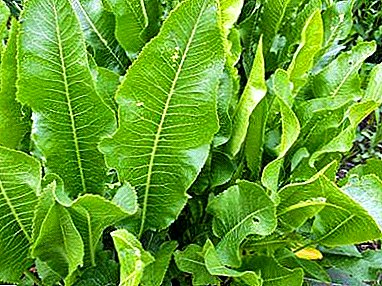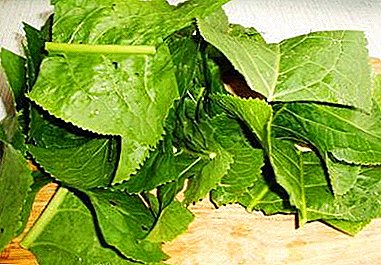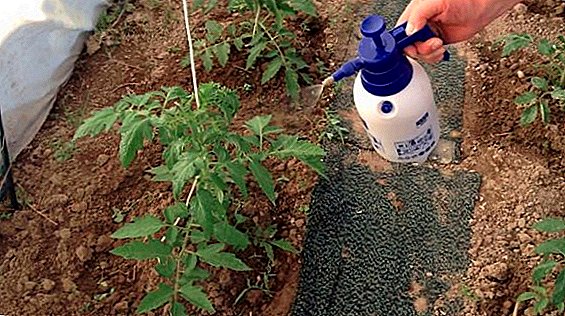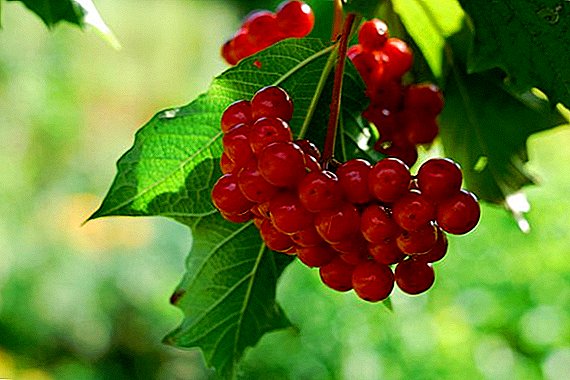
The healing properties of horseradish leaves have long been appreciated by traditional medicine. Absolutely not demanding to care, the ubiquitous and very quickly breeding plant can get rid of a wide variety of ailments.
From the article you will learn about the chemical composition and nutritional value of the leaves of this plant. What are the benefits of horseradish leaves? What are the indications and there are contraindications to their use?
The reader is presented with several recipes based on horseradish leaves for the treatment of salt deposits, osteochondrosis, to combat extra pounds, also as a diuretic and for cleaning the body.
Appearance
Horseradish is a plant belonging to the Cabbage family. Radical leaves of horseradish are large, oblong, oval, chenate, heart-shaped at base. Lower leaves pinnately-separated, oblong-lanceolate. Upper - linear, entire. Leaf color - deep green.
A photo
You will see how the leaves of the plant look like:



Chemical composition and nutritional value
The healing properties of horseradish leaves are due to the presence of allyl essential oil, biologically active substances, vitamin C and trace elements in the plant tissues. In addition to ascorbic acid, horseradish leaves are rich in vitamin B, carotene, nicotinic and phosphoric acid, potassium, iron, magnesium, sulfur and copper. Leaves contain proteins, fats and carbohydrates. The plant is a natural antibiotic., phytoncides in its composition prevent the development of pathogens.
Health benefits and harm
What is the benefit of this plant? It has the ability to excrete toxic substances from the body. A large amount of fiber in the leaves normalizes intestinal motility. Horseradish leaves are an excellent stimulant for physical and psycho-emotional fatigue, as well as indispensable in the treatment of colds.
The plant has a very low glycemic index, which makes its use absolutely harmless for diabetics. People with excess weight horseradish leaves will help to lose weight, thanks to its ability to speed up the metabolism. The rich chemical composition of the plant helps to maintain the beauty of hair and strengthen nails.
As with any healing remedies, the benefits of horseradish leaves are combined with properties harmful to the body. Even for healthy people it is recommended to limit the use of horseradish, if they have an increased sensitivity.
External use is prohibited in the presence of damaged skin.
Watch the video about the benefits of horseradish leaves:
Indications and contraindications for use
The wide range of beneficial properties of horseradish leaves is impressive.
Successfully They can be used in the treatment of:
- Pathological conditions of the respiratory system. To provide an effective healing effect on the body, horseradish leaves can with chronic cough, asthma, pleurisy and pneumonia.
- Failure of the gastrointestinal tract. Horseradish leaves will help in case of insufficient contraction of the intestine and reduction of bile excretion, the plant will also be effective in gastritis with low acidity.
- Urolithiasis, cystitis, kidney stones.
- Blood disorders and iron deficiency anemia.
- Violations of the cardiovascular system, hypertension, arrhythmias, atherosclerosis.
- Stomatitis and toothache.
Also effective is the treatment of horseradish leaves in case of menstrual disorders, prostatitis and prostate adenoma, dropsy, metabolic disorders, osteochondrosis, malaria, gout and rheumatism.
It is strictly not recommended to use horseradish leaves in the following diseases:
 Peptic ulcer and gastritis with high acidity. Irritant properties of the plant will increase the secretion of gastric juice, which will exacerbate the symptoms of the disease.
Peptic ulcer and gastritis with high acidity. Irritant properties of the plant will increase the secretion of gastric juice, which will exacerbate the symptoms of the disease.- Acute and chronic intestinal inflammation. Irritant effect of essential oil in enteritis, colitis, diseases of the duodenum will aggravate the course of the disease.
Also eating horseradish leaves is not desirable for future mothers, due to the fact that the plant has a stimulating effect on intestinal motility and irritates the mucous membranes.
During breastfeeding, eating horseradish leaves should also be discarded. Milk becomes bitter and colic may appear in the baby. Children under seven years old horseradish is also contraindicated, as it can cause burns to the mucous membranes.
Recipes from this plant for treatment
Salt deposits
Would need:
- Young leaves horseradish.
- Boiling water.
- Film (scarf or shawl).
Cooking:
- Leaves boiling water.
- Apply to the diseased area on the chest, cervical or waist section.
- The compress is left overnight, secured with a film and, if desired, additionally covered with a warm scarf or scarf.
- In the morning, the compress is removed. White scurf remains on the skin - these are salts that horseradish has pulled out. Plaque need to erase.
- Compresses make a ten-day course. If the patient's condition suggests that during this time the final result is not achieved, treatment can be continued.
Video on the use of horseradish leaves for the removal of salts from the body:
Osteochondrosis
Alcohol tincture of horseradish leaves is perfect for the treatment of osteochondrosis, as a method of ingestion, and for rubbing during massage.
 For the manufacture will need:
For the manufacture will need:
- Fresh horseradish leaves.
- Vodka of good quality.
Cooking method:
- Wash, dry and fill the leaves with a small glass jar.
- Top up with vodka, close tightly and put in the refrigerator.
- A week later, the tincture can be consumed, pre-strain.
When ingested one tablespoon of tincture is mixed with a small amount of honey and taken several times a day, a course not exceeding two weeks.
Cleaning the body
Would need:
- Chopped horseradish leaves - 1 cup.
- Wine - 4 glasses.
Cooking:
- Crushed raw materials should be folded in a glass container, filled with wine, covered with a lid and left in a dark place for two weeks at room temperature.
- After the allotted time, filter the tincture and use one tablespoon half an hour before meals.
- The course can last from one to three months.
Fighting overweight
Ingredients:
- Celery - 300 gr.
- Horseradish leaves - 200 gr.
- Kefir or sour milk - 1 cup.
Cooking:
- Grate celery.
- Chop the leaves of horseradish.
- All ingredients pour kefir.
- Salad is divided into two portions and is eaten once a day.
Diuretic
Ingredients:
- Fresh horseradish leaves.
- Pure water.
Cooking method:
- In a liter glass jar place crushed leaves.
- Pour clean water.
- Put for two weeks in a dark place, tightly closing the jar lid.
- After the required period has expired, strain the infusion and store it in a cool place.
Drink three times a day for half an hour before meals for three months.
The therapeutic power of horseradish leaves is truly unique in its breadth.. Affordable, and at the same time very effective, healing medicine can be prepared both in the season of growth of horseradish and in winter, having previously prepared the leaves for future use.


 Peptic ulcer and gastritis with high acidity. Irritant properties of the plant will increase the secretion of gastric juice, which will exacerbate the symptoms of the disease.
Peptic ulcer and gastritis with high acidity. Irritant properties of the plant will increase the secretion of gastric juice, which will exacerbate the symptoms of the disease.









